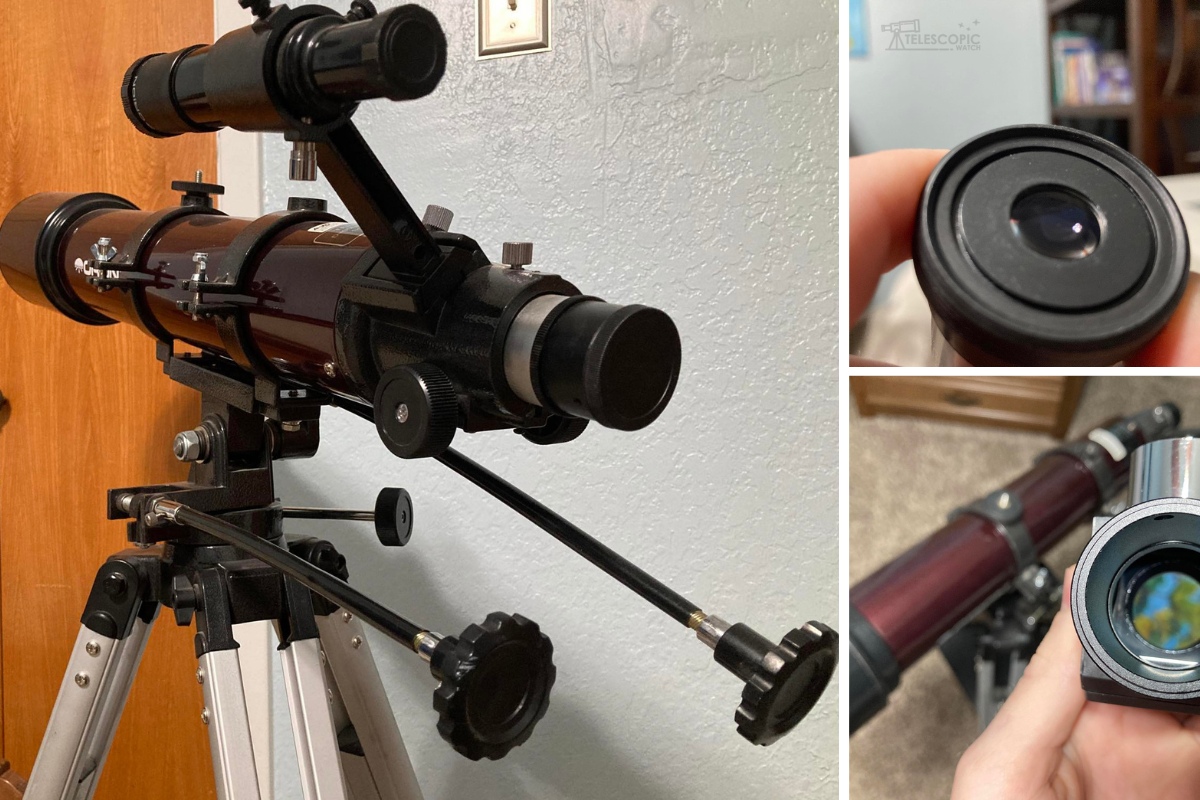The Optical Tube of Orion Starblast 90
The StarBlast 90 is a 90mm f/5.6 achromatic refractor telescope.

At the focal ratio of f/5.6, StarBlast 90 is going to, of course, have a lot of chromatic aberration, and the scope does so as I expected. This means that the scope is, in practice, limited to using rather low magnifications. At high magnification powers, the images quickly become fuzzy, and, of course, the Moon, planets, and bright stars will have ugly purple halos around them due to the chromatic aberration.
The telescope, unfortunately, has some other optical issues that I least expected and that are a lot more troublesome.
The images are just not very sharp, even at low magnification. To me, this seems to be due to a poor job in the manufacture of the lens itself. Now, that’s really a wonder since it is kind of hard to mess up a cheap refractor objective lens. Additionally, I noticed a lot of problems with stray reflections and glare, which were most likely due to poor interior blackening and baffling.
Unusually, StarBlast 90 has a lens cap that remains attached when it is taken off of the front. Holding on by a tiny strip of plastic, it’s only a matter of time before it breaks and leaves your cap on the ground, and quite possibly on snow or wet grass.
Lastly, the telescope optical tube attaches to its tripod with a standard ¼ 20 threaded hole, meaning it’s possible to easily install it on a photo tripod or bolt a dovetail on to attach it to a real-quality astronomical mount (not that I would consider it to be worthwhile).
The 1.25″ Focuser
The StarBlast uses a 1.25” rack-and-pinion focuser. Like many scopes in its price range, this focuser is unfortunately all-plastic.
The 1.25″ focuser on the StarBlast is definitely one of the worse ones, as it wiggles a lot as you rack it in and out, which is a real nuisance.
Unusually, the focuser also has a bubble level and compass built into it. I have absolutely no idea what it is doing on this telescope, but it is utterly pointless and it would’ve been wise if the manufacturers put the money spent on it into some of the other, more lacking areas of this telescope.
Reviewing the Starblast 90’s Accessories
The StarBlast 90 comes with two eyepieces: 25mm and 10mm Kellners, providing 20x and 56x, respectively; a 45-degree erecting prism; a 5×20 finderscope; and Orion’s MoonMap 260 (a nice, if unnecessary, bonus).
Orion sells a kit that adds a 2x Barlow and a dinky red flashlight, along with the above accessories. I’d advise you not to bother. The Barlow is good but of no use on such a low-quality telescope, and the flashlight is really cheap.
The Lower-quality Eyepieces
I found the included 25mm and 10mm Kellners to be mostly plastic and lower in quality than the kit Kellners often supplied with many inexpensive telescopes. They have a rather narrow field of view (less than 50 degrees) and seem to have internal reflection issues.
Despite this, Orion actually makes a point in their advertising to brag about their supposed quality, calling them “quality Kellner eyepieces (not cheapie ‘H’ eyepieces like with most other brands)”. In truth, they are not of high quality and are only slightly better than the Huygens eyepieces included with some of the really cheap scopes on the market.
The Diagonal
The included diagonal is a 45-degree erecting prism design. This prism makes for upright and non-reversed images (you can read a newspaper looking through it, unlike a normal star diagonal, which will show a mirror image flipped left-right), but at the expense of viewing comfort and image quality.
The diagonal not only has a nearly all-plastic build, but the prism induces annoying diffraction spikes on bright stars and planets, reducing the already-low image quality even further. It really should be replaced by a quality 90-degree mirror or prism star diagonal.
The Finderscope
Then there’s the finderscope.
A 5×20 finder is already a terribly small instrument, barely able to show you anything in the sky at all. This one makes matters worse by adding its own miniature 45-degree erecting prism, which gobbles up the finder’s already feeble ability to gather light. Thanks to the erecting prism, the finder isn’t even useful as a peepsight.
What’s more is that the whole finder, including seemingly even the objective, is made of plastic.
The finder attaches to the scope simply via a plastic tab and notch, making replacing it with a new finder quite a hassle.
The Mount’s Capabilities
The StarBlast 90’s mount is a joke. It is basically a very cheap photo tripod head affixed to a moderately sufficient steel tripod.
While the tripod would do an okay job supporting the telescope, in practice, the terrible mount head makes the scope’s motions jerky, wobbly, and impossible to fine-tune. There are no slow-motion adjustments.
It is never quite balanced. The locking mechanisms are poor and do not allow for anything other than overly-loose motion that makes the scope impossible to keep pointed at or alternatively, overly tight, jerky movements.
If the bad optics and poor accessories didn’t already convince you to avoid the scope, the unworkable mounting should.


